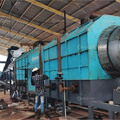In the ongoing quest for sustainable solutions to combat climate change and enhance agricultural productivity, biochar pyrolysis has emerged as a promising technology. This process not only transforms organic biomass into a valuable carbon-rich material but also contributes to carbon sequestration in soil. In this comprehensive exploration, we delve into the intricacies of biochar pyrolysis, its benefits for soil health, and its role in shaping a climate-positive future.

Understanding Biochar Pyrolysis:
Biochar pyrolysis is a thermochemical process that involves heating organic materials, such as agricultural residues, wood, or other biomass, in the absence of oxygen. This controlled burning process, also known as pyrolysis, converts the organic matter into biochar – a stable form of carbon that can persist in the soil for centuries. The biochar pyrolysis reactor is the key part in pyrolysis.
The biochar produced through pyrolysis is characterized by its porous structure, high carbon content, and stability against decomposition. These properties make biochar an ideal soil amendment, enhancing both physical and chemical aspects of soil quality.
The Carbon Sequestration Aspect:
One of the key contributions of biochar pyrolysis to a climate-positive future is its ability to sequester carbon in the soil. By locking carbon into a stable form, biochar helps mitigate the release of carbon dioxide (CO2) into the atmosphere, a major driver of global warming. Unlike traditional biomass burning, which releases carbon back into the air, biochar sequesters carbon effectively, acting as a long-term carbon sink.
Soil Health Benefits:
1. Improved Water Retention:
Biochar's porous structure acts like a sponge, enhancing the soil's water retention capacity. This is particularly beneficial in regions facing water scarcity, as it helps plants access water more efficiently, reducing irrigation needs.
2. Enhanced Nutrient Retention:
Biochar has a high cation exchange capacity (CEC), allowing it to retain and exchange essential nutrients with plant roots. This property reduces nutrient leaching, ensuring that fertilizers and essential minerals remain in the root zone, promoting plant growth.
3. Microbial Habitat Enrichment:
The porous nature of biochar provides a habitat for beneficial microorganisms. These microbes contribute to the breakdown of organic matter, nutrient cycling, and the overall improvement of soil microbial diversity. Healthy microbial communities are crucial for nutrient availability and plant health.
Sustainable Agriculture Practices:
1. Reduced Greenhouse Gas Emissions:
The incorporation of biochar into agricultural soils reduces the need for frequent tillage, a practice that can release stored carbon and contribute to greenhouse gas emissions. By enhancing soil structure, biochar promotes no-till or reduced-till farming methods, mitigating emissions and promoting sustainable agricultural practices.
2. Bioenergy Byproduct Utilization:
Biochar pyrolysis often produces bioenergy as a byproduct, in the form of syngas or bio-oil. Utilizing these byproducts for energy can contribute to a closed-loop system, where waste biomass is transformed into biochar and clean energy, further reducing the environmental footprint of agriculture.
Real-World Applications:
Several case studies around the world demonstrate the practical application and success of biochar pyrolysis in diverse environments. From small-scale farmers in developing countries to large commercial agricultural operations, the benefits of biochar are evident in improved crop yields, soil fertility, and climate resilience.
1. Amazonian Terra Preta:
The Amazon rainforest is home to Terra Preta, or “dark earth,” a type of fertile soil enriched with biochar. This anthropogenic soil, created by indigenous populations centuries ago, remains highly productive and showcases the long-term benefits of incorporating biochar into agricultural systems.
2. European Agroforestry Practices:
In Europe, agroforestry systems have integrated biochar application to enhance soil fertility and sequester carbon. These practices contribute to more sustainable and resilient agricultural landscapes, addressing both climate change mitigation and adaptation.
Challenges and Research Frontiers:
While the potential benefits of biochar pyrolysis are significant, challenges and areas of ongoing research persist. These include:
1. Feedstock Selection:
The choice of biomass feedstock influences the properties of biochar. Research focuses on identifying optimal feedstocks for specific soil and climate conditions to maximize biochar's benefits.
2. Optimizing Pyrolysis Conditions:
Fine-tuning the pyrolysis process, including temperature, residence time, and reactor design, is crucial for achieving desired biochar characteristics. Ongoing research aims to optimize these conditions for different applications.
3. Scaling Up Production:
While biochar pyrolysis has proven effective on various scales, scaling up production for widespread adoption poses logistical and economic challenges. Research and development efforts are underway to streamline production processes and make biochar more economically viable.
Global Initiatives and Policy Implications:
Governments, NGOs, and international organizations recognize the potential of biochar pyrolysis in addressing climate change and promoting sustainable agriculture. Initiatives supporting research, development, and the implementation of biochar technologies are gaining traction. Policymakers are exploring ways to incentivize the adoption of biochar in agricultural practices, recognizing its role in achieving climate goals.
Educating and Engaging Communities:
The success of biochar pyrolysis in promoting carbon-rich soil and a climate-positive future relies on widespread awareness and community engagement. Educational programs, farmer training initiatives, and collaborative efforts between governments, researchers, and local communities play a crucial role in fostering understanding and adoption of biochar technologies.
Future Outlook:
As we celebrate the potential of biochar pyrolysis in creating carbon-rich soil and contributing to a climate-positive future, the road ahead holds promise. Ongoing research, technological advancements, and global collaborations are expected to further refine biochar production processes and expand its application in diverse agricultural settings.

Conclusion:
In conclusion, biochar pyrolysis stands as a beacon of hope in the quest for sustainable agriculture and climate-positive practices. By enriching soil with carbon, mitigating greenhouse gas emissions, and enhancing agricultural productivity, biochar has the potential to transform the way we approach land management. As we look to the future, the integration of biochar pyrolysis into mainstream agricultural practices offers a tangible and scalable solution to address climate change while fostering resilient and productive landscapes.





